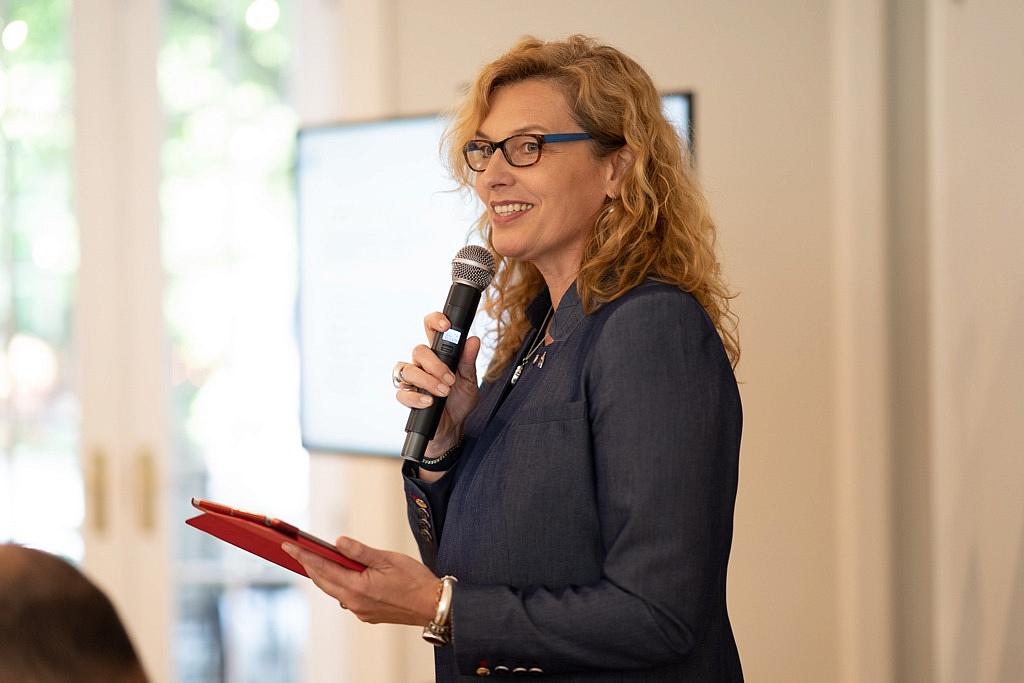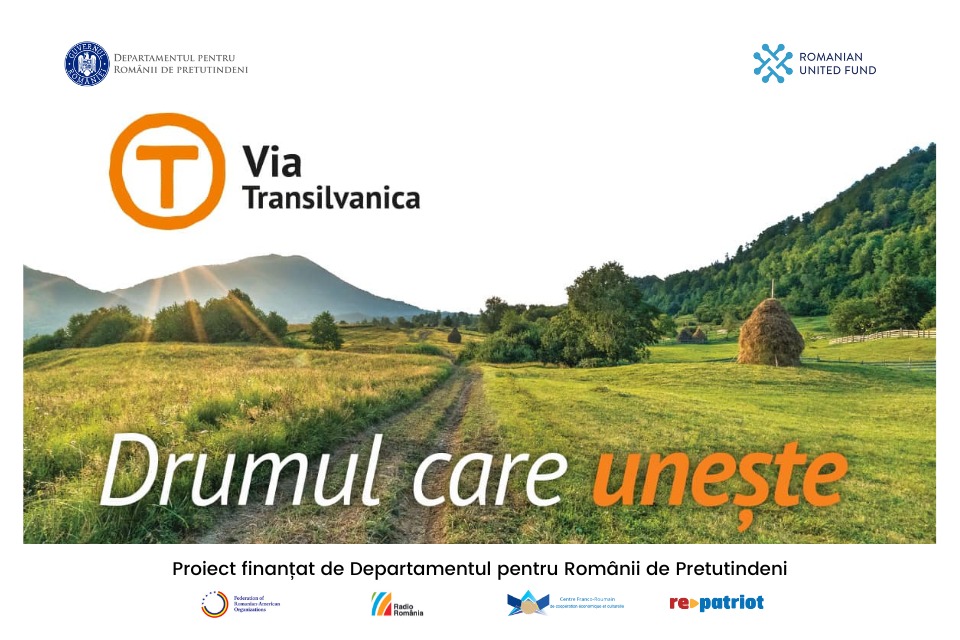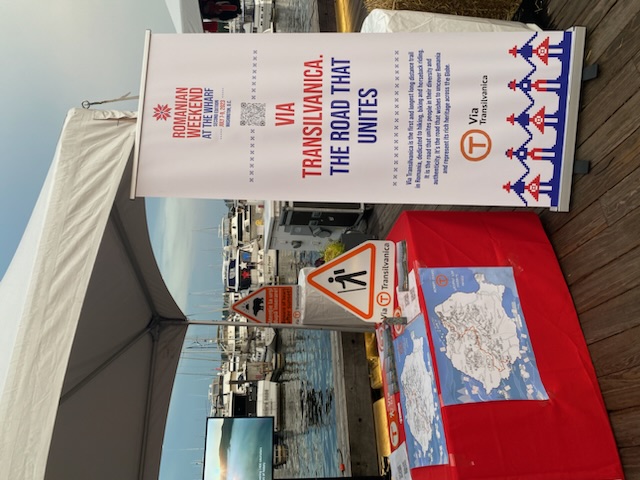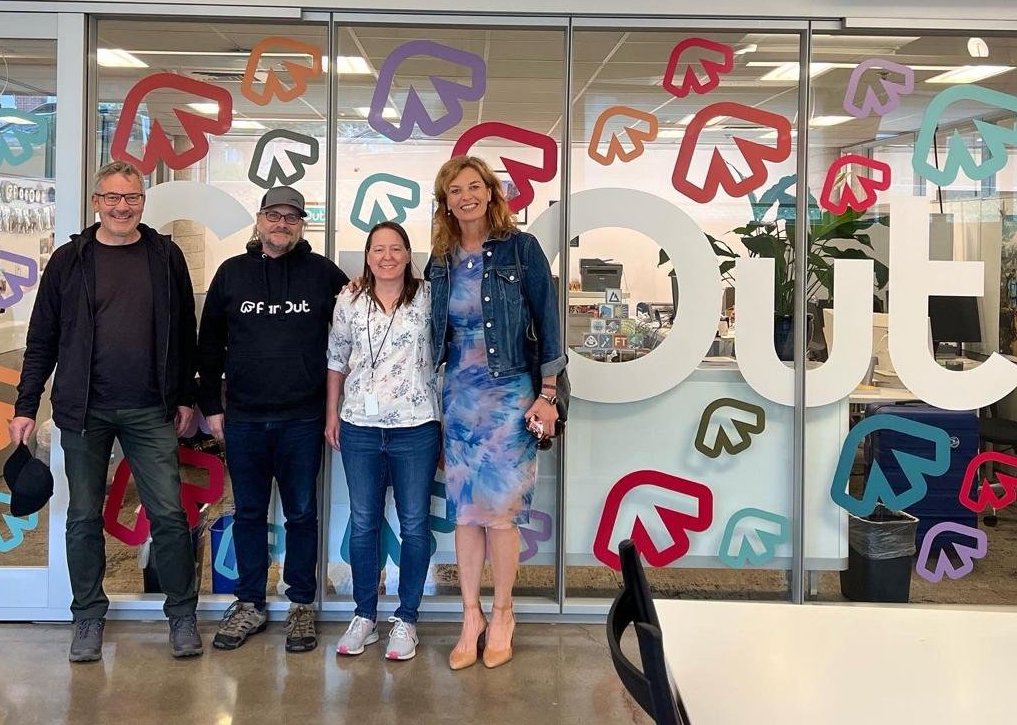Daniela Kammrath, founder of Romanian at Heart: For those of us who left the country, projects like Via Transilvanica are part of what we love and miss most about Romania

Via Transilvanica, the long-distance trail crossing Romania, talks about the country in a way no other project has done before, believes Daniela Kammrath, the founder of Romanian at Heart, a community for people from around the world who love the country. While it offers a way for people of all nationalities to experience the country's culture, the trail can carry a particular meaning for Romanians who live outside the country's borders.
Daniela Kammrath has seen the interest that Via Transilvanica can generate among a diverse public as she helped introduce the project to the D.C. community by adding it to the map of the U.S. tour for the screening of the documentary Terra Banatica, detailing the part of the efforts to set up the trail, and presented the project at the Romanian Weekend at The Wharf event this summer.
Through Corvin Art, established with her partner, a sculptor, she held a call for artists to come up with design ideas for the milestones on Via Transilvanica. On more than 1,400 kilometers, the trail is marked with andesite milestones sculpted by Romanian or foreign sculptors in the Tășuleasa Social campus sculpture retreats. The milestones, alongside other signage elements of the project, are meant to support the trail's mission to be a route on which no hiker is allowed to get lost.
Kammrath, who is also the CEO of the Washington-based non-profit RAISE (Romanian American Institute for Smart Energy), board member of Romanian United Fund, and a founding member of the Federation of Romanian-American Organizations (FORA), urges people to support the trail further. Not only for what it stands for but also for the determination and creativity of the team working to make the project happen. Unlike similar projects known internationally, the Romanian long-distance trail has been developed through private efforts. "The more support we show, the easier it will be for them to continue this dream. It's really easy to help if you want to," she argues.

More on how Via Transilvanica has sparked the enthusiasm of the U.S. public and why it is important to support it further in the interview below.
What was your first contact with the Via Transilvanica project, and what attracted you to it?
Daniela Kammrath: I have known Alin [e.n. Ușeriu] for quite a while since I was living in Romania and had my women's website. We promoted some of their ecological and environmental projects. But I have met him at the [e.n. Romanian United Fund (RUF)] Gala, in 2019. I was already on the board of RUF at the time, and it was just a very exciting evening.
There were, I think, well over 300 people in the room at Stan Mansion in Chicago. Everybody was electrified by the prospect of supporting the project. The way we presented it was an offer for people to sponsor one kilometer of the road. There were over USD 110,000 fundraised that night, if I remember correctly. It does not sound like a big amount. Still, it was quite impressive for this to happen in one evening, considering that the money was fundraised from individuals.
So, that was the first time I met with Alin and Ana [e.n Szekely] from Via Transilvanica.
Through Corvin Art, you launched a call for artists to develop design ideas for the milestones on Via Transilvanica. How did that project come about?
Daniela Kammrath: We went and visited Tășuleasa Social in 2021. I wrote ample articles about our visit on Romanianatheart.com, a community I nurture. We wanted to meet the artists in residence there. There were six or seven sculptors; we met them and Andrei Boitan, the artist who organizes the residences at Tășuleasa and got to know them better.
So, we learned more about their passion for this project and how much time they put into it. We realized that this should become a project known to international artists. When we returned to D.C., we put together this call for art for American artists. We got only a handful of projects, but what was good from our point of view is that we made the project known to the American community of artists.
We want to follow up with taking some American sculptors to Tășuleasa to be in that environment and get more Americans excited about the project. Besides getting the Romanian diaspora to support the project, I think the most important thing we have learned in the last four years is that Americans are excited when they find out about it. I go around (with the VT sticker on my phone), and people ask me about the project. The most exciting part to me is that people are curious about it.

How many artists were selected in the end? Where are their works now?
Daniela Kammrath: We didn't select artists; we selected artwork. I think we had around five or six art milestones designed, and we sent the artwork to the team of sculptors that are working on it in Piatra Fântânele, at Tăşuleasa. I cannot tell you right now where those milestones actually are. But to us, it was just a test to see if this works and if the artists would be excited to go and experience this at the sculpture camp.
We have a handful who want to go there. C-19 has dampened our planning, but we are trying to find the right time for them to travel to the camp and create a program where they can be part of the group that sculpts. Then, these artworks will be placed somewhere along the way. We are still making the plans.
You applied to receive one of the Via Transilvanica kits. How do you hope it will help the activities you run in your community? How does it compare to other efforts to promote the country?
Daniela Kammrath: I helped introduce Via Transilvanica to the D.C. community, placing D.C. among the nine cities for the U.S. tour of the documentary [e.n. Terra Banatica]. We were hosts here with Ambassador Andrei Muraru and the entire team at the embassy. That was the first time we introduced Via Transilvanica to our community. We also had artwork that we presented there, hoping to sell it for fundraising. We were not able to sell it at that time, but we are still up for that.

Then, this summer, during the Romanian Weekend at The Wharf event, we created a tent for Via Transilvanica with the help of the Romanian Embassy and the Romanian Cultural Institute in New York. We presented the film; we had the signage, the booklets, miniature milestones, and the map. It was in the same place where we placed the [e.n. the neon artwork showing the words] "Mi-e dor de tine" (I miss you) last year.
There were close to 10,000 people who passed by. It was the second tent from the entry on the pier. Everybody stopped at it and asked us about Romania; some knew about Via Transilvanica. I remember a teenager from Pennsylvania - we had a 15-minute Romanian lesson with her because she wanted to know how to pronounce "hello," "goodbye," "I love you," and all that. Most importantly, there were people of all ages: some spoke Romanian, some knew of Romania, and some didn't have a clue. They loved how the map looked; they commented on it- the one with the VT trail marked. I remember there were a lot of elderly people who were about to go on a cruise on the Danube, and they said, "We're going to Brașov; it's that close to Via Transilvanica?" The interaction was very exciting because they all were trying to picture themselves being on Via Transilvanica.
To me, the beauty of that weekend was all the people who didn't know about it and found out. That was a good indication that this would be worth an entire tour. We had people who said, "I'm buying a ticket. I'm planning to go next year." As you know, Americans don't have a lot of holidays, and they have to plan ahead. There were couples where one of the people was excited, and the other one was like, "Let me think about it." I hope the excited one wins over.
This [kit] is a great opportunity to allow other people and organizations in different cities in the United States to set it up easier, not to figure out where to put what and how to get the materials. […]
What's most important is that this is something that people can talk about. Some Americans knew about țuică [e.n., a type of plum brandy], and some of them knew about mămăligă [e.n. Romanian for polenta]. It is exciting because this is the easiest way to get people to experience our culture and get them enthusiastic about this amazing project that talks about Romania in a way that no other project has done.
People have a good recollection of some of the sad or trying moments in our history. But this project brings to them the beauty of this land that we all have in our hearts, Romanian or not.
I hope this experience can repeat itself in as many cities as possible. I'm grateful that the Embassy and the Romanian Cultural Institute recognized that it would be a good piece of the puzzle for Via Transilvanica to be part of the Romanian Weekend in D.C. But having this kit will make it easier for everybody to set it wherever possible. And I'm happy to have it here in D.C., ready.

Via Transilvanica is often described as an ambassador for Romania. Why do you think that is?
Daniela Kammrath: Well, it's interesting for all kinds of people and stakeholders, groups of people. For example, when I approached FarOut, the hiking app based in Denver, for them to list Via Transylvania, they were thrilled. I was with Alin when we signed the contract in June 2022, and they were so excited to meet him and share VT with their hiking community. Because it has the culture and artwork, it has all the pieces that could make it a memorable experience - the food, the people, the different regions it goes through, and so forth. It is considered the longest art exhibition in the world.
It is easy to know and remember certain things about Romania that, for many people in the diaspora, become clichés. But when you start talking about this road that unites over 400 communities and goes through those beautiful landscapes and the team's work, I think it shows this project's beauty, determination, and creativity. That is impossible not to fall in love with. I mean, give me one negative aspect about it.
But I do know that this doesn't come for free. The organization puts a lot of time and effort into it. There are a lot of people here in the US who support the project. RUF is instrumental in coalescing all those forces and all this energy. I took it forward because I'm based here in D.C. and did my part to continue to support it. Ultimately, we hope to get together all the Romanians who live abroad in meaningful ways to support this because this will continue to take a lot of time and energy.
I have been following the project team, and I see how often they have to go back and fix things. There are still crazy people who ruin some of the signposts, and I even saw a milestone that was taken down. So much time and effort still need to be put into this, and we should support it. It should not be only on the shoulders of one organization.

If we love a project, an artist, or an athlete, we should support them. We should put our efforts, money, time, and everything we can into supporting those projects and people because they will not happen alone. When we realize we can make a difference with the price of a cup of coffee or by taking the word further, sharing a message, or talking about it, we give power to what we are proud of.
Some people might still believe they are too small and can't make a difference, but they can, with a word, a share, the price of a cup of coffee, or by organizing a night with friends where they see the documentary. Then they can decide: "I can go on Via Transilvanica in the summer and bring three of my friends." What I like about this project, as a marketing and communication person and a fundraiser, is that it empowers everybody to participate in something bigger than anyone who has created or supported it.
And if we want this project to be here in 20, 50, or 100 years, like El Camino or the Appalachian Trail, we need to put in the effort because, right now, this project is built with private funds and people who believe in their wild dreams. You've got to go and meet those sculptors, the team, and Tanti Aurica, who cooks there. It's just beautiful!
If we can put this forward for people to learn about it, they'll get hooked and embrace it. What Via Transilvanica delivers - besides the hard figures of 1,400 kilometers, 400 villages, and so many thousands of people that it reaches – is empowering. It is the same way you feel when you have your own accomplishments.
Walking, running, biking, and buying something from someone in one of the villages along the trail will make you feel good. I hope Romanians feel like this back home, but mostly, all the diaspora thinks this could be part of what they could support.
Via Transilvanica won this year the Public Choice Award at the Europa Nostra Awards with a record number of votes. Did you expect this to happen? What does it tell you about the project and about the communities who rallied behind it?
Daniela Kammrath: I'm glad it had so many votes. I was very happy to see it was the most-voted project. I wish people would vote more often and in bigger numbers. I'm excited about the number - we all did it, RUF did it. Putting the spotlight on Via Transilvanica at the European level and beyond can really help. It can help the project to get more momentum in its quest to make it last and keep it going at this level of professionalism.
I'm grateful that people voted, but I urge them to vote in bigger numbers and ask their friends to do it because that is the easiest thing we can do for a project. And also in our daily lives, since this will be very important to do the next year: Go Vote!
Is there something else you would like to add about the project?
Daniela Kammrath: Thank you for getting involved and supporting this project. You can reach the Romanian and expat communities and, hopefully, some diaspora communities.
For those of us who live abroad - and this is why I also came up with Romanianatheart.com - these kinds of projects like Via Transilvanica mean so much more because they are part of what we love most and part of what we miss most about Romania: the hospitality, the kindness, the creativity, the beauty. I know it can be hard sometimes, but the most important thing is that you keep those good things with you. Again, I am proud to be part of it and to be able to promote a great project like this one.
These are very small things that each of us can do. And from small, then you might want to do more. This is when I urge people to be greedy, to want to be more and do more.
For us Romanians abroad, Romania has a different meaning, and I don't see how anybody could not like what this project brings to our lives. If you meet them, put me in touch. I'll talk to them!
The most important thing is to support them and show them we are together and that they are not alone. Because, at the end of the day, they are there to pay the bills and make it happen. But the more support we show, the easier it is for them to keep this dream alive. It's really easy to help if you want to.
---
---
This interview was written by the Romania Insider team for the Romanian United Fund as part of the project "Drumul Care Unește", with the support of the Romanian State Department for Romanians Abroad.
Acest interviu a fost realizat de către echipa Romania Insider pentru Romanian United Fund în cadrul proiectului „Drumul Care Unește”, realizat cu sprijinul Departamentului pentru Românii de Pretutindeni.













